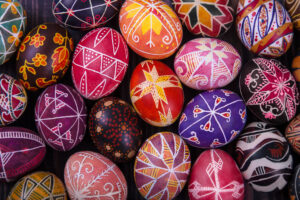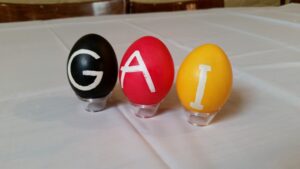The symbolism and significance of the time-honored labor of love.
By Audra Grigus

Easter is fast approaching and if you’re in tune with Central and Eastern European traditions, you have probably seen or heard of pysanky. A pysanka is an egg, a symbol of life and fertility, that is decorated in bright colors and an ornate wax design. While many countries have their own version of it, pysanky is best known for coming out of Ukraine. The name comes from the Ukrainian word pysaty which means “to write.” The oldest pysanka found was excavated in Lviv in 2013 in a rainwater collection system from around the 15th century.
There is an abundance of folklore and superstitions surrounding pysanky. In Ukraine, many believe that a pysanka can protect people and households from evil spirits and chaos. An old myth states that older people should be given gifts of pysanky with darker colors and rich designs, as their life had been fulfilled. Adversely, young people should be given eggs with white as the main color, as there is still much to be written in the story of their lives.

Geometric symbols are widely used today and can have many meanings. For instance, the triangle can represent the Holy Trinity; the elements of air, fire and water; a traditional family (man, woman, and child); or the cycle of life (birth, life, and death). Pysanky with spiral motifs are the most powerful, demons and other monsters are said to get trapped within the spirals forever. Other important symbols include spiders, meaning patience and happiness; flowers, to represent wisdom and beauty in life; birds, the messengers of good news and springtime; and butterflies to signal transformation.
Colors also play a large part in the symbolic nature of the eggs, blue for good health, black for remembrance and respect, red for love and friendship, and periwinkle for everlasting love.
Ukraine is not the only country that has their own traditions with ornately embellished and symbolic eggs…
- Belarusians (пісанка, pisanka)
- Bulgarians(писано яйце, pisano yaytse)
- Carpatho-Rusyns (писанкы, pysankŷ)
- Croats (pisanica), Czechs (kraslice)
- Hungarians (hímestojás)
- Lithuanians (margutis)
- Poles (pisanka)
- Romanians (ouă vopsite, încondeiate or împistrite)
- Serbs (pisanica)
- Slovaks (kraslica)
- Slovenes (pirhi, pisanice, or remenke)
- Sorbs (jejka pisać)
The Sorbian people, a Slavic community that is generally concentrated in the Spree River Valley in Eastern Germany, have a style that is also often simply called Sorbian Easter Eggs. While there are a few similarities in symbolism between Ukrainian and Sorbian eggs, such as how triangles can represent the father-mother-child trio and the Holy Trinity, there are also some significant differences. For the Sorbian people, circles generally represent the sun or sunshine and triangles can also represent wolf teeth, which drive away evil.
While writing on these eggs takes many hours and is certainly a labor of love, the tradition lives on with as much significance today as it did far back in time.
